Jill Magid’s work examines the hierarchies of power — the hidden power structures inherent in our culture. Asking how one gains access to that which is inaccessible, Magid identifies loopholes in these systems, subverting their functions through playful manipulations of the rules. I believe that Magid’s quest to understand these systems on an intimate level and her tenacious persistence is a means to claim power (with a small p). This is what allowed her to convince the Amsterdam police to hire her as a security ornamentation professional to decorate the city’s Police surveillance cameras with rhinestones. (System Azure Security Ornamentation, 2002)
And through these methods of deep inquiry, resourcefulness and play, she gained access to Liverpool’s closed–circuit video surveillance system and convinced the Liverpool Police to film her on the streets and then release the footage to her. (Evidence Locker, 2004)
These methods further enabled her to convince a Brooklyn transit officer to allow her into his subway inner sanctum, in post 9/11 New York (Lincoln Ocean Victor Eddy, 2007); led her to be commissioned by the Dutch Intelligence Agency to find the human face of their secret institution (The Spy Project, 2005-10); and allowed her to gain access from the Mexican congress to the remains of a Pritzker Prize-winning Mexican architect and to create a diamond from them in order to question the corporate control of his archive (The Barragán Archives, 2013-16).
Magid’s interdisciplinary practice is not easy to categorize. She is not a performance artist, yet her work is performative. She is not a photographer or video artist, yet she employs both mediums in her projects, and directed her first feature film, The Proposal, in 2018. She is a prolific writer and thinker — all of which she manifests in her work.
Magid’s current Focus exhibition at The Modern Art Museum of Fort Worth features works that developed from her 2020 Creative Time public art work Tender, in which she engraved the edges of 120,000 2020 pennies with the phrase “The Body Was Already So Fragile.” The pennies’ total value equates to one stimulus check dispersed during 2020 by the U.S. government as part of the CARES act. Magid distributed the pennies throughout bodegas in the five boroughs of New York. The work captures the collective anxiety and tension during the pandemic and explores ideas around economic and human value. Her exhibition at The Modern includes new drawings, sculptures, and installation alongside the film Tender Balance, which loosely tracks the dissemination and spread of the pennies throughout the city.
Below is a lightly edited interview I had with Magid about her show and project.
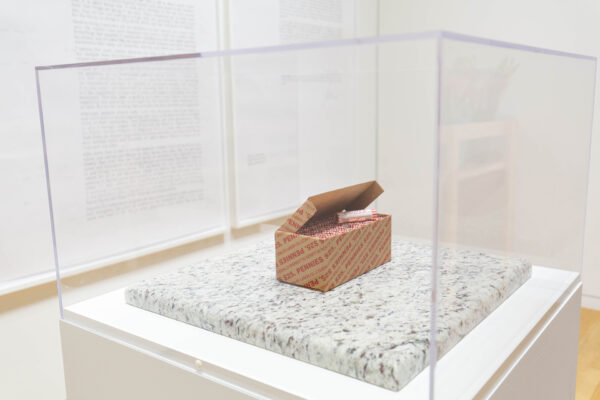
Installation view, Jill Magid, “Tender Box,” (2021) 50 rolls of 2020 edge-engraved U.S. pennies, custom-printed coin wrapper, cardboard. Photo courtesy of Modern Art Museum of Fort Worth
Colette Copeland: There’s so much to unpack with this work. The exhibition’s timing is darkly serendipitous with the increase of cases of the omicron variant in Texas and across the nation. I was reading what Creative Time’s Curator, Justine Ludwig, wrote about your public art project, questioning what the word “body” in the engraved phrase referred to — the human body, the national and global economic body, or the body politic. It was so disheartening to see how the media and leaders politicized the issue, rather than focusing on people and their health. The penny is such a salient metaphor for the lack of regard for the human body, as something of little worth or something to be discarded. People were scared to touch/handle money or coins, fearing contagion. Yet as Ludwig stated, copper is an antimicrobial material, killing the virus on contact. What were some of the reactions you received during the distribution of the pennies and/or the reactions to the work as a public art project?
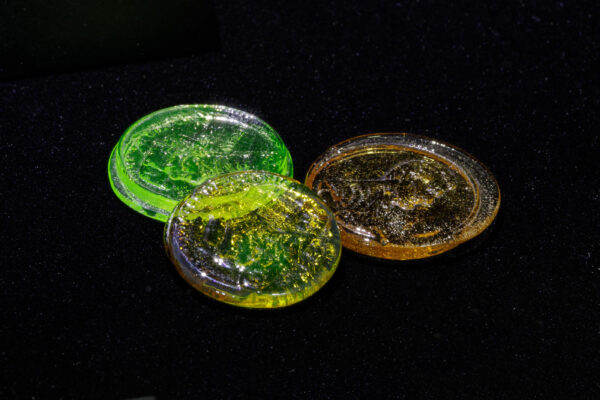
Jill Magid, “2020 Glass Pattern Penny,” 2021, flameworked and mold-pressed glass (amber, amber-uranium, uranium, recycled uranium), brass and steel mount, wooden pedestal. Photo credit: Useful Art Services
Jill Magid: The pennies spread like a rumor. Once Tender entered circulation, it disappeared from my view, entering the economy and passing through people’s hands. I am happy not to control their reception. But I found it interesting when the work started circulating in cultural sectors, in ways I hadn’t expected. In the video How To Unwrap a Tender Penny Without Damaging the Wrapper, a faceless woman with amazingly manicured nails teaches viewers of the coin enthusiast website CoinMoscow.com how to do what the title suggests. Some people sold Tender pennies on eBay, for far above their face value. It was surprising to many people first handling the Tender pennies how shiny and beautiful newly minted pennies are. Many people behind the registers initially questioned if they were real. Copper so quickly loses its luster, absorbing the oils and dirt on people’s hands.
CC: The title Tender reflects the complex multiplicity of meanings in the work. I think about tenderness as a quality of showing concern and compassion, as well as a part of the body that is hurt or bruised — “tender to the touch.” A lesser-used meaning is tender as a system of bartering or offering money for payment. The various connotations lend themselves to the personal as well as the collective. The act of offering a penny not only as a symbol for the time, but as a marker for future encounters intrigues me. Knowing that this work will continue to circulate for forty years is a long legacy for an art work. The exchange of money serves as an intimate act, one that the receiver may not realize.
JM: Yes, exactly. This is what I mean about “rumor.” And like a rumor, which changes each time it is retold, so will the interpretations of the public artwork Tender.
CC: The film Tender Balance is a haunting portrayal of isolation and collective fear. Beautifully filmed and edited, the scenes that are devoid of human presence such as the industrial settings of penny production and the large container storage units (presumably holding bodies), sharply contrast crowded street corners and traffic, where everyone is masked. The second part focuses more on individual people. I appreciate the close shots of masked faces and the expressiveness and individuality in the hands. Can you talk more about the piece’s key themes, as well as the role of sound in evoking emotion and providing additional context?
JM: Tender Balance is an experiential film, rather than a documentary. In the film, you hardly see any of the engravings on the penny edge, although you see a lot of cash and coinage in circulation. You also don’t see me involved in their distribution. Usually, I am the protagonist of my work, but in this film, I wanted the pennies to take on that role. The emphasis is on gesture and touch: hands touching money and hands touching other hands. The film follows the flow of coinage, via cash-in-transit trucks, and the movement — or lack of movement, as in the case of the refrigerated trucks, of bodies, and how they are similarly treated. Loud industrial sounds of coin production and packaging fill the score initially; the cacophony of money and machines. And then the sounds of the city mixed with those internal to the human body. The trucks — both the cash-in-transit trucks and the refrigerated trucks —are characters, with their exhaust and humming. I wanted to use the pennies’ dissemination as a way to intimately explore the circulation of cash, and the vulnerabilities of those involved in those transactions. The way the film is shot, as well as its original score, embodies that moment at the beginning of the pandemic when every touch felt dangerous. I was thinking about value, and how value — both human and economic — was being discussed in the media, about who is valued in our society, and who isn’t.
CC: Let’s discuss the other components of the project, which focus on labor and the essential workers during the pandemic. The work questions the notion of who/what is essential, revealing how so many frontline workers, such as the bodega workers, risked their lives daily, and for very low wages. In the Labor Day series, you meticulously hand-draw projections of presidential documents signed by Trump in 2020 and Biden in 2021 which are archived in the federal register. While the documents serve as rhetoric surrounding the topic of labor, your performative actions make what’s implied but invisible, visible.
JM: Labor Days consists of two sets of large drawings: Labor Day, 2020, signed by Donald Trump, and Labor Day, 2021, signed by Joseph R. Biden. I drew larger than life versions of these Presidential proclamations — that had been published in the Federal Register — by hand in pen, while tallying the labor it took to produce them in the margins in pencil. The Federal Register, published every weekday since 1937, functions as a kind of rule-book or daily diary of the U.S. government. It is designed to inform the public about proposed rules, notices, and presidential documents, so that citizens can actively participate in government rule-making, although I don’t believe many people know about it. By drawing these official proclamations about labor, and specifically what we now call Essential Labor, I insert my own labor into them. This felt like a way to engage the government, via this public-facing publication, in a similar gesture to the engraved pennies. Only with the pennies, my authorship, and my hand, were invisible. In Labor Days, my manual labor is clear; my notations marking my labor-time (which points to the fluctuating schedule of a working mother/artist) are specific and personal.
CC: I read that you will install Bodega Flowers in the same gallery as Labor Days. Tell us more about this installation.
JM: Bodega Flowers (2022) is an installation consisting of cellophane-wrapped, fresh cut flowers in buckets, arranged on wooden tiers on entry of the gallery which also holds Tender Box and Labor Days. I wanted to evoke the tiers of flowers that line the facades of many NYC bodegas. Cut flowers are already dead; their life, or maybe I should say their afterlife as commodities, is ephemeral and bittersweet. These kinds of bouquets, sold at bodegas in NYC or grocery stores in Texas, are easily accessible, not expensive, and replaceable. I like their relationship to Labor Days.
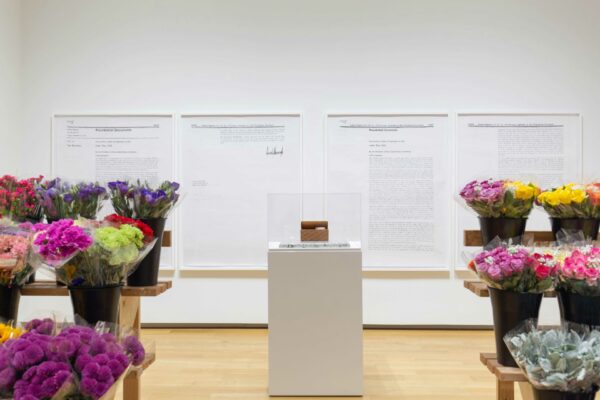
Installation image, Jill Magid, “Bodega Flowers,” (2022) and “Labor Days” (2020/2021). Photo courtesy of Modern Art Museum of Fort Worth.
CC: The three other works in the middle gallery — the U.S. mint ballistic bag, the 2020 Pattern Penny mold that you designed based on the 1943 U.S. proposed glass mold, and the X-ray of a penny lodged in your son’s chest all evoke a powerful sense of loss. How do they add to the context of the show?
JM: I made those pieces alongside editing the film, and they share a similar feeling of absence. In those three works, circulation was only imagined, as in 2020 Pattern Penny, being obstructed as in the x-ray, or with the ballistic bag, being temporarily removed from it.
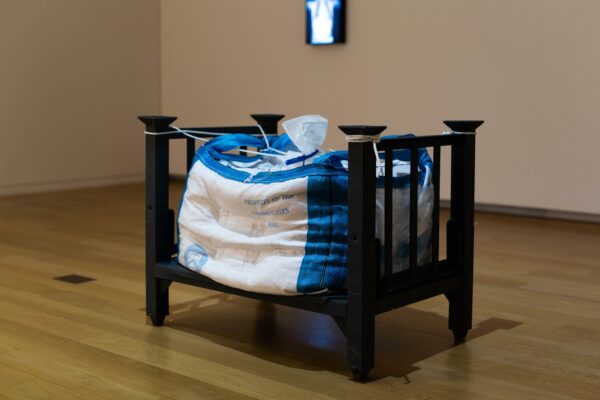
Installation image, “2020 Cents / U.S. Mint Ballistic Bag,” $4,000 Value, Partially Dispersed, 2021, 280,000 uncirculated 2020 U.S. pennies, metal skid (on loan from U.S. Mint), ballistic bag (on loan from U.S. Mint). Photo courtesy of Modern Art Museum of Ft. Worth
CC: I read a lot of quotes about pennies. Most were trite, but this one by Barbara Kingsolver resonated with me. “Few people know clearly what they want. Most people can’t even think what to hope for when they throw a penny in a fountain.” What is your hope for viewers as well as participants in the project?
JM: In this moment when Omicron is surging, the Great Resignation continues, and the Child Tax Credit is ending, I think it is hard to know what to hope for exactly right now. The pandemic did not create these vulnerabilities, tensions and questions around value, it only made them harder to ignore.
CC: In thinking about this project within your larger practice, I see key elements which recur in many of your works, such as inserting yourself within systems of power in order to challenge established notions and rules. There is also a performative and personal aspect to these interventions that elevates the human connection over the system/institution. I remember when I introduced you for your lecture at Richland College, I quoted Primo Levi who stated that an artist’s first responsibility is to bear witness. Yet, your role as an artist is never content with only bearing witness. You make the invisible visible and humanize that which is thought to be inhuman. What has your latest work revealed in your growth as an artist and human?
JM: Thank you, I appreciate what you say here, and it is true, I am not content to simply bear witness. I cannot understand a system without engaging it, and I cannot recognize a system if it does not recognize me back. After making Tender Balance and thinking so much about the afterlives of pennies, as well as my own absence, it feels good to find myself laboring, putting my body, my hand, and visibly back into the work. Looking through my practice, I am always in the work, although sometimes it is my absence and the void it creates that is part of the work. I think reappearing and considering my own labor as a physical and visual material of the work coincides with how I feel coming out of this first wave of the pandemic.
Focus: Jill Magid is on view at The Modern Art Museum of Fort Worth through March 20, 2022. There will be an artist talk with Magid on Tuesday, March 1, 2022 at 6 pm.


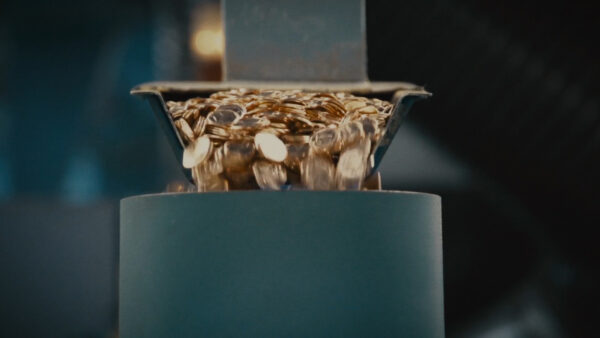

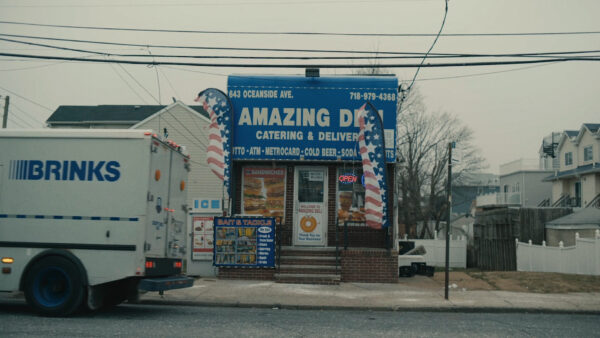


1 comment
Lovely and insightful interview. Appreciate this deeper understanding of her work.